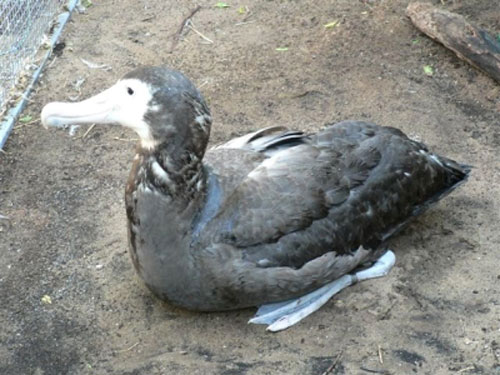Louise Riotte-Lambert and Henri Weimerskirch (Centre d’Etudes Biologiques de Chizé, Villiers en Bois, France) have used satellite telemetry to compare the foraging movements of juvenile, immature and breeding adult Wandering Albatrosses Diomedea exulans, publishing their findings in the Proceedings of the Royal Society Biological Sciences.
The paper’s abstract follows”:
“Foraging skills of young individuals are assumed to be inferior to those of adults. The reduced efficiency of naive individuals may be the primary cause of the high juvenile mortality and explain the deferment of maturity in long-lived species. However, the study of juvenile and immature foraging behaviour has been limited so far. We used satellite telemetry to compare the foraging movements of juveniles, immature and breeding adult wandering albatrosses Diomedea exulans, a species where foraging success is positively influenced by the distance covered daily. We showed that juveniles are able to use favourable winds as soon as the first month of independence, but cover shorter distances daily and spend more time sitting on water than adults during the first two months after fledging. These reduced movement capacities do not seem to be the cause of higher juvenile mortality. Moreover, juveniles almost never restrict their movement to specific areas, as adults and immatures frequently do over shelf edges or oceanic zones, which suggest that the location of appropriate areas is learned through experience. Immatures and adults have equivalent movement capacities, but when they are central place foragers, i.e. when adults breed or immatures come to the colony to display and pair, immatures make shorter trips than adults. The long duration of immaturity in this species seems to be related to a long period of learning to integrate the foraging constraints associated with reproduction and central place foraging. Our results indicate that foraging behaviour of young albatrosses is partly innate and partly learned progressively over immaturity. The first months of learning appear critical in terms of survival, whereas the long period of immaturity is necessary for young birds to attain the skills necessary for efficient breeding without fitness costs.”

A juvenile Wandering Albatross
Reference:
Riotte-Lambert L. & Weimerskirch, H. 2013. Do naive juvenile seabirds forage differently from adults? Proceedings of the Royal Society Biological Sciences 280: 20131434. http://dx.doi.org/10.1098/rspb.2013.1434.
John Cooper, ACAP Information Officer, 10 November 2013

 English
English  Français
Français  Español
Español